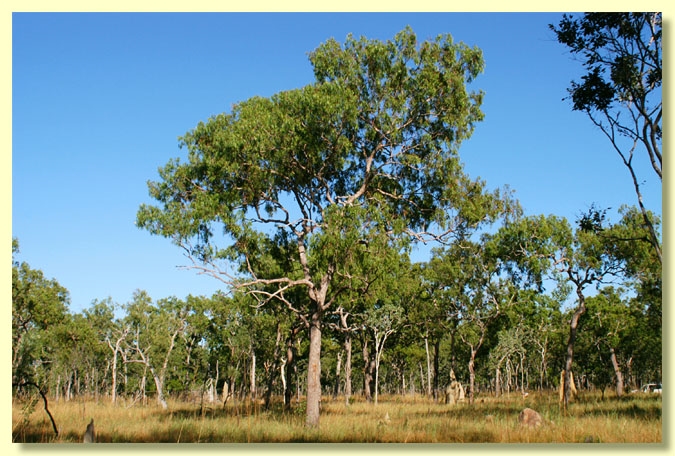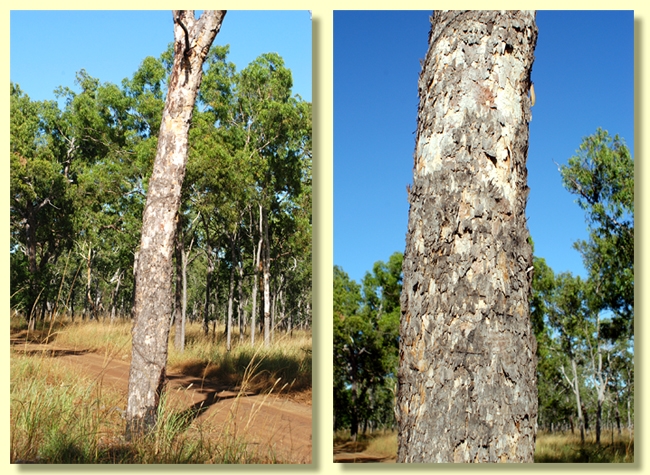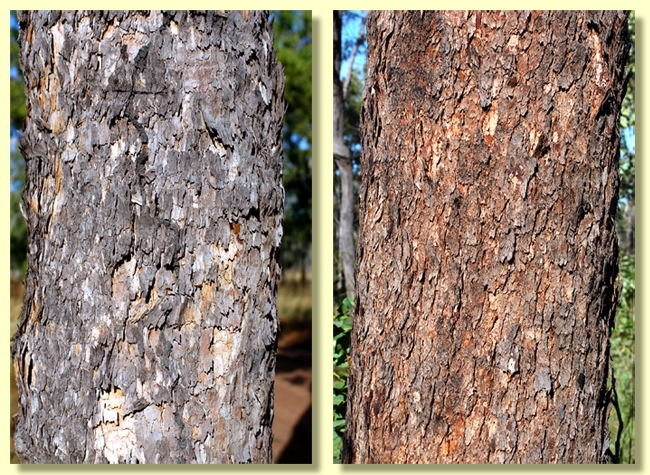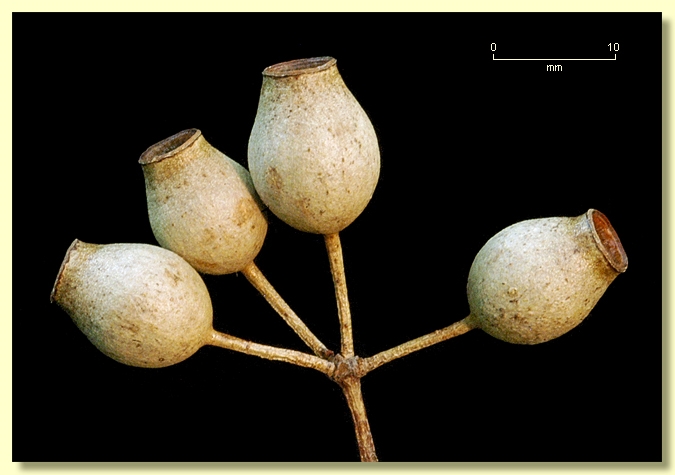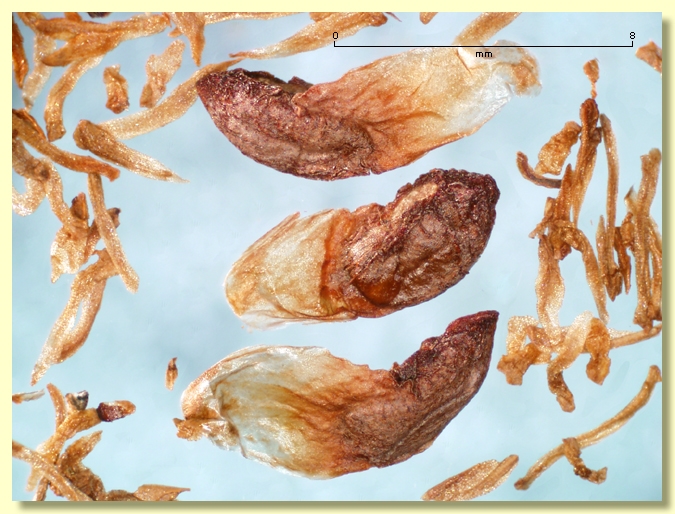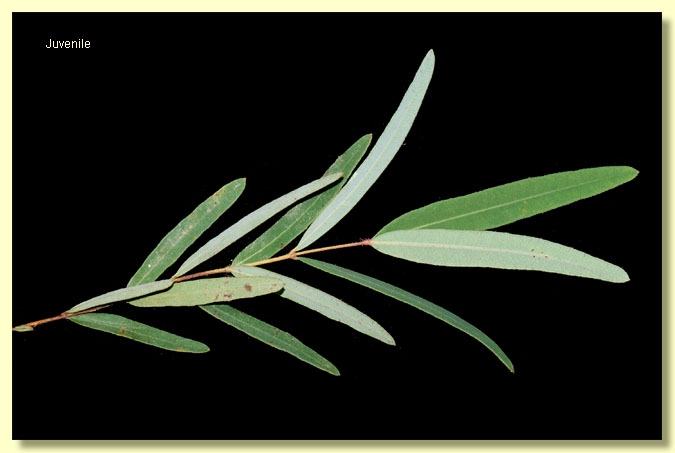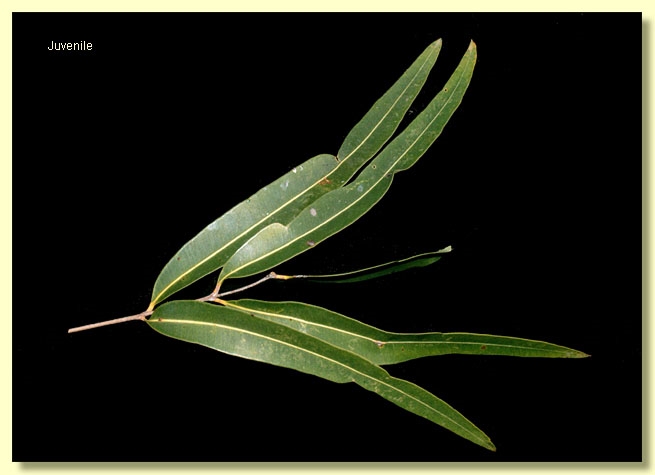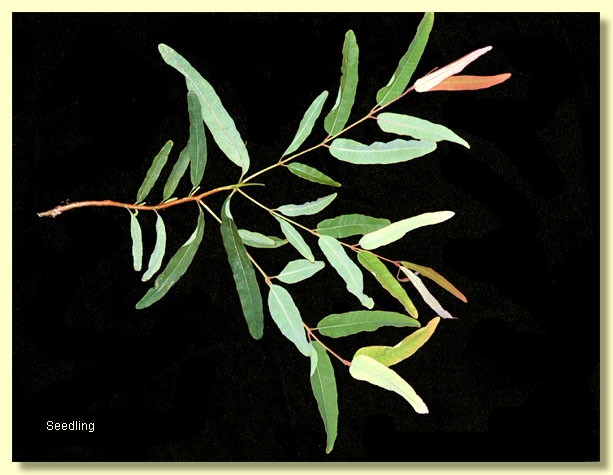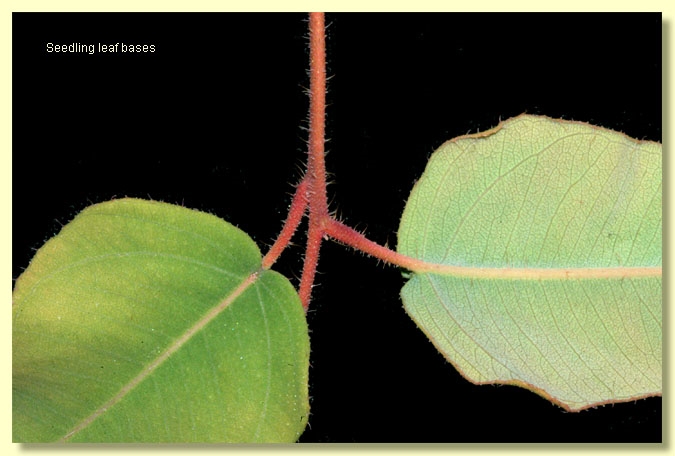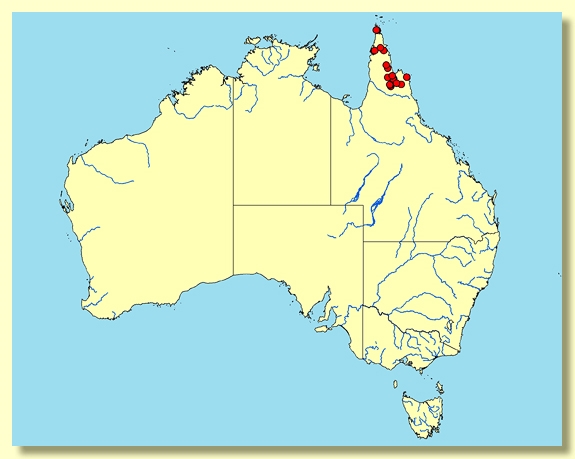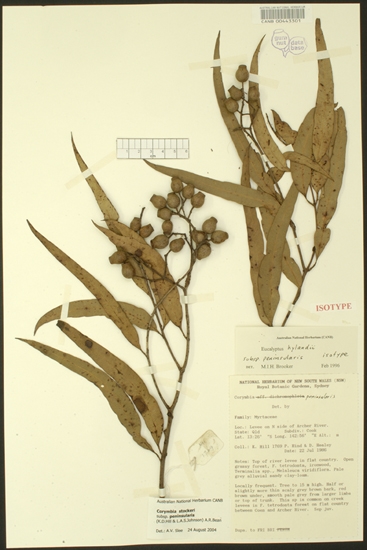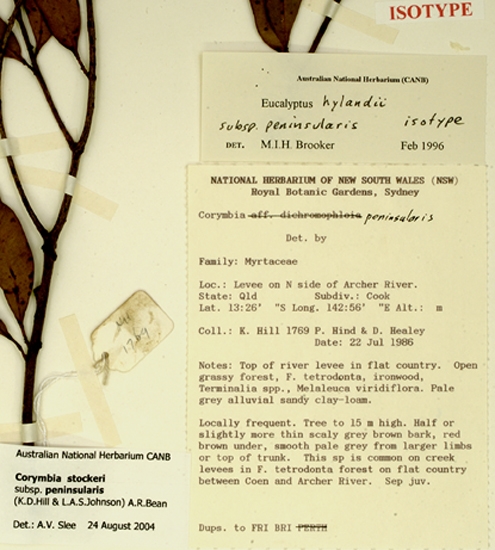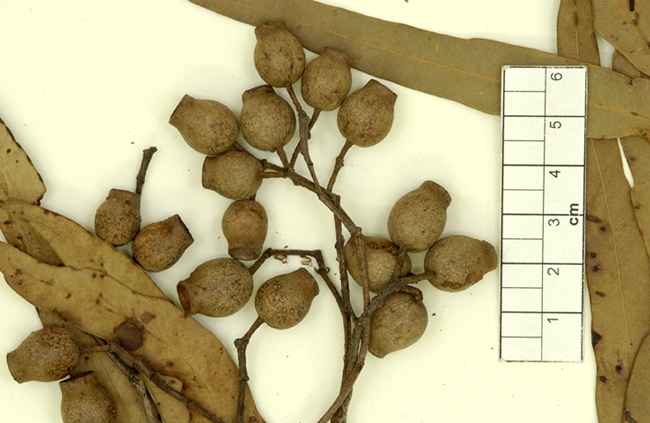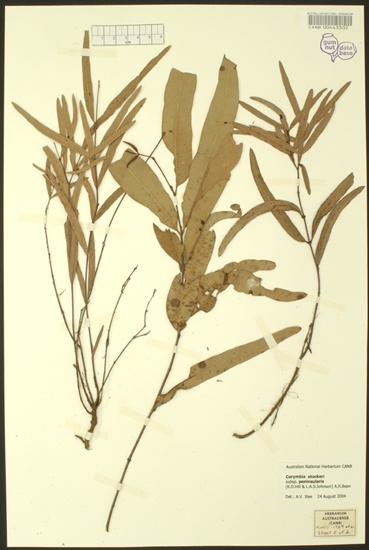Corymbia | Rufaria
Euclid - Online edition
Corymbia stockeri subsp. peninsularis
Corymbia stockeri subsp. peninsularis (K.D.Hill & L.A.S.Johnson) A.R.Bean, Austrobaileya 6(2): 345 (2002).
Tree to 20 m tall. Forming a lignotuber.
Bark rough over part or most of trunk but rarely extending to the larger branches, thin and scaly to coarsely flaky, tessellated, orange-brown to reddish brown to grey-brown with reddish underbark, middle-order and smaller branches usually smooth, pale grey to creamy white and pinkish.
Branchlets smooth (glabrous); elongated oil bodies (ducts) sometimes present in the pith.
Juvenile growth (coppice or field seedlings to 50 cm): stems rounded in cross-section, scarcely setose on lower part, soon smooth (glabrous); juvenile leaves sessile to shortly petiolate, opposite until ca node 25, narrowly elliptic to narrowly lanceolate, 9–14.5 cm long, 0.9–1.3 cm wide, base tapering to petiole, apex pointed, glossy, green, discolorous, predominantly glabrous, setose on underside of lowest leaves only.
Adult leaves alternate, petioles 0.8–1.8 cm long; blade lanceolate, (7)9.3–21.5 cm long, (0.6)0.9–2.3 cm wide, base tapering to petiole, margin entire, apex finely pointed, discolorous, glossy, green, smooth, side-veins greater than 45° to midrib, reticulation dense to very dense, intramarginal vein present, oil glands island, one per areole, or obscure.
Inflorescence terminal compound, peduncles slender 0.7–1.2 cm long, buds 7 per umbel, pedicels 0.4–1.2 cm long. Mature buds pyriform to obovoid to ovoid, 0.6–0.7 cm long, 0.4–0.5 cm wide, smooth on surface (no scurf), scar absent (both opercula shed together at flowering), operculum shallowly rounded sometimes apiculate, stamens inflexed, all fertile, anthers oblong, dorsifixed, versatile, dehiscing by longitudinal slits, style long and straight, stigma blunt but with a fringe of papillae visible, locules (3)4, the ovules not arranged in clear rows on the placentae or if so then rows 5. Flowers creamy white.
Fruit pedicellate (pedicels 0.3–1.2 cm long), urceolate with a short erect neck with rim slightly flared, 1–1.7 cm long, 0.8–1.3 cm wide, longer than wide, disc descending vertically, valves (3)4, enclosed.
Seeds brown, 6–9 mm long, ellipsoidal with terminal wing, hilum ventral.
Cultivated seedlings (measured at ca node 10): cotyledons large, reniform; stems rounded in cross-section, setose with bristle-glands for up to ca 20 nodes; leaves shortly petiolate (to 0.8 cm), opposite to sub-opposite at ca node 10–12, leaves narrowly elliptic-lanceolate, (6.3)9–11.5 cm long, 0.9–2.8 cm wide, base lobed, rounded or tapering to petiole, often peltate for a few nodes, discolorous, glossy, green, sparsely setose with bristle-glands and simple white hairs arising from the epidermis also present on underside, until ca node 15, then glabrous.
Flowering time unknown.
Corymbia stockeri is a bloodwood tree species restricted to Cape York Peninsula in northern Queensland. It has two subspecies:
C. stockeri subsp. stockeri
Restricted to the Stannary Hills west of Atherton, where it occurs in woodland on stony ridges with little soil. Bark is rough throughout, crown leaves are glossy and discolorous, dark green above and paler underneath, whilst the juvenile coppice growth is setose on stems and has elliptic-lanceolate leaves usually with peltate leaf bases for several nodes before developing tapered leaf-bases. Buds may be very thinly scurfy and whitish due to the presence of a rubber cuticle starting to detach, or the surface can be smooth and not white. Fruit may have speckles.
C. stockeri subsp. peninsularis
More widespread than subsp. stockeri, over the length of Cape York, occurring from the upper Palmer River and Morehead River area north to Coen, Wenlock River area, Batavia Downs and east of Weipa, on Horn and Thursday Islands in Torres Strait. Subsp. peninsularis has thinner, redder rough bark rarely extending beyond the trunk onto the branches, glossy discolorous crown leaves, narrower and more linear juvenile leaves that are sparsely setose for many nodes. Buds are smooth and never whitish. Subsp. peninsularis is found in forest and woodland often with E. tetrodonta over a grassy understory, on sandy soils on river levees and gently sloping hills. Speckles absent from fruit (fide Bean 2002).
Originally described by Hill & Johnson (1995) as C. hylandii subsp. peninsularis, this subspecies was transferred to C. stockeri subsp. peninsularis by Bean (2002), noting particularly the glossy crown leaves, differences in extent of rough bark.and presence/absence of speckles on the fruit. The closely related C. hylandii is a predominantly dull-leaved species (unlike both subspecies of C. stockeri) and has thickly tessellated grey-brown bark (rough bark thick or thin in C. stockeri but with reddish brown tones). C. hylandii also has narrower juvenile and seedling leaves than either subspecies of C. stockeri.
Other rough-barked bloodwoods with discolorous leaves that could possibly be confused with C. stockeri subsp. stockeri in its natural range are: C. clarksoniana, which differs in having obviously scurfy buds, fruit that are usually longer (dimensions overlap), and juvenile leaves that are wider; C. abergiana, which has more stout buds that are scurfy, and also sessile much larger fruit; C. intermedia, which has slightly larger fruit compared with subsp. stockeri, and differs also in the juvenile leaves, which are wider and not as glossy; C. rhodops, which has larger fruit and, uniquely, when in flower has cream stamens and a red centre (the ovary roof); C. trachyphloia, which has smaller buds and fruit and, unlike any of the above species, has wingless seeds. C. serendipita differs from subsp. stockeri by the dull adult leaves and buds that are never scurfy or white.
Compared with C. stockeri subsp. peninsularis, C. hylandii differs in the more extensive rough bark, and dull not glossy adult leaves. C. novoguinensis, C. clarksoniana and C. polycarpa all differ from subsp. peninsularis in the quite scurfy buds and longer fruit. C. nesophila differs from subsp. peninsularis in the sometimes smaller fruit (dimensions overlap) and large ovate/cordate juvenile leaves.
One of the difficulties in working with this group of species, where diagnostic features rely heavily on leaf surface characteristics, is that leaves that are glossy when fresh in the field do not necessarily retain the gloss in the dried state as herbarium specimens. In addition the keen botanist may have to wait to see what the buds are like, if none are immediately available. The species in this group and other bloodwoods of the Atherton, Stannary Hills, Newcastle Range and southern Cape York area in particular need further study.
MORE ABOUT CORYMBIA
MORE ABOUT RED BLOODWOODS
Corymbia stockeri: after Dr. Geoff Stocker (1941– extant 2006).
Geoff Stocker was tropical botanist and forester with the Forestry and Timber Bureau first in the Northern Territory and later at the Forest Research Institute (FRI) research station at Atherton, north Queensland. (The FRI and the Atherton research station during this time became part of CSIRO Forest Research.) He is principally interested in ecology and management of tropical ecosystems.
subsp. peninsularis: Latin peninsula, referring to the subspecies occurrence on Cape York Peninsula, Queensland.

